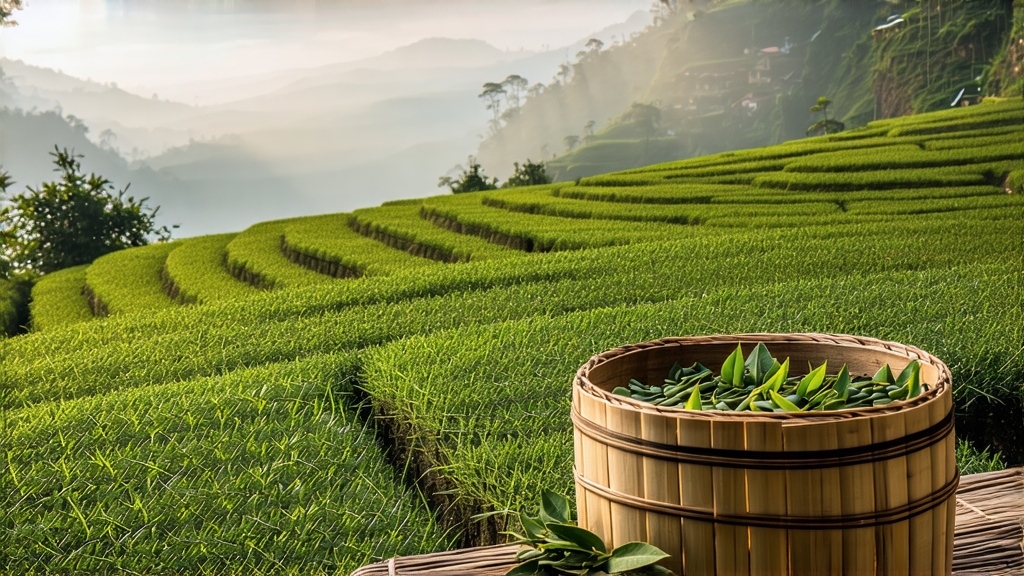
Tucked high on the mist-capped Meng Ding ridge of Sichuan province, Meng Ding Huang Ya has been whispered about in Chinese tea texts for more than twelve centuries. Legend credits the Buddhist monk Wu Li-zhen with planting the first seven bushes on the summit during the Tang dynasty; by the Song era the leaves were pressed into tiny golden cakes and carried by caravan to the imperial court, earning the phrase “the tea that outshines gold.” When Ming scholars replaced compressed tea with loose leaf, the same gardens adapted their craft, giving birth to the yellow-hued, downy-bud style we now call Meng Ding Huang Ya—literally “Meng Peak Yellow Bud.” It is one of China’s three canonical yellow teas, yet outside the Middle Kingdom it remains a quiet aristocrat, its subtlety often eclipsed by the louder flavors of green or black teas. This article invites the global tea traveler to listen more closely.
Although all Meng Ding Huang Ya originates within the 20 km² core zone around the mountain, micro-terroirs create three recognized grades. “ summit bud” is picked between the Qingming and Grain Rain festivals at 1 400 m, where nightly cloud cover slows photosynthesis, concentrating amino acids; only unopened shoots, still shielded by a single fish-scale leaf, qualify. “Cloud terrace bud” grows on 1 000 m ledges where afternoon sun is stronger, yielding a slightly grassier cup. “Valley yellow” comes from 600 m hedgerows, harvested one week later; it receives a shorter sealed-yellowing and is considered an everyday tribute rather than a courtly gift. Regardless of grade, the raw material must pass the “three no’s”: no open leaf, no purple variegation, no insect bruise.
The magic of yellow tea lies in an extra, labor-intensive step known as men huang—“sealed yellowing.” After a brief withering under soft mountain wind, the buds are pan-fired in bamboo-ratten drums at 160 °C for exactly four minutes; this kills the green enzymes but leaves a whisper of moisture. While still warm, the tea is wrapped in thick hemp cloth and placed inside a cedar box. For the next 48 hours the leaves stew in their own residual heat and exhaled CO₂, edging the chlorophyll from jade to antique gold and coaxing a hint of maillard sweetness reminiscent of fresh chestnut. Every six hours the master opens the bundle to aerate and re-tumble, judging readiness by aroma alone: when the green sharpness has mellowed into warm grain and orchid, the buds are given a final low-temperature drying over charcoal embers. The entire cycle demands 72 hours without break; one lapse and the tea slips into green or, worse, stale compost. Thus each kilogram needs roughly 42 000 hand-picked buds and the undivided attention of a single craftsman.
To unlock the tea’s quiet opulence, treat it like a shy princess: coax, never bully. In a 120 ml gaiwan, pre-warm the vessel with 85 °C water, then gently pour 3 g of buds—about a level tablespoon—against the wall to avoid cracking the down. The first infusion, 30 seconds, produces a pale chardonnay liquor with a rising note of baby corn and freesia. The second, at 20 seconds, broadens into sweet cream and wet slate. By the third, lengthen to 40 seconds; the cup turns golden amber, revealing a savory umami echo that Japanese gyokuro drinkers will recognize, yet cleaner, lifted by a cool mountain minerality. Four infusions is common for summit grade, five for cloud terrace. Always decant completely; trapped liquor will flatten the delicate aromatic arc. If western teaware is preferred, use one heaped teaspoon per 250 ml, 80 °C, and steep two minutes, but expect only one resteep of equal quality.
Professional cupping follows a quiet choreography. First, inhale the dry aroma: top-grade buds smell like toasted rice cracker mingled with linden blossom. Next, examine the wet leaf on a white porcelain plate; ideally 80 % remain single, intact spears with a buttery yellow-green hue. The liquor should be brilliantly clear; any cloudiness signals rushed yellowing. When slurping, let the tea spray across the palate, then close the lips and breath out through the nose; a cooling sensation at the back of the throat—